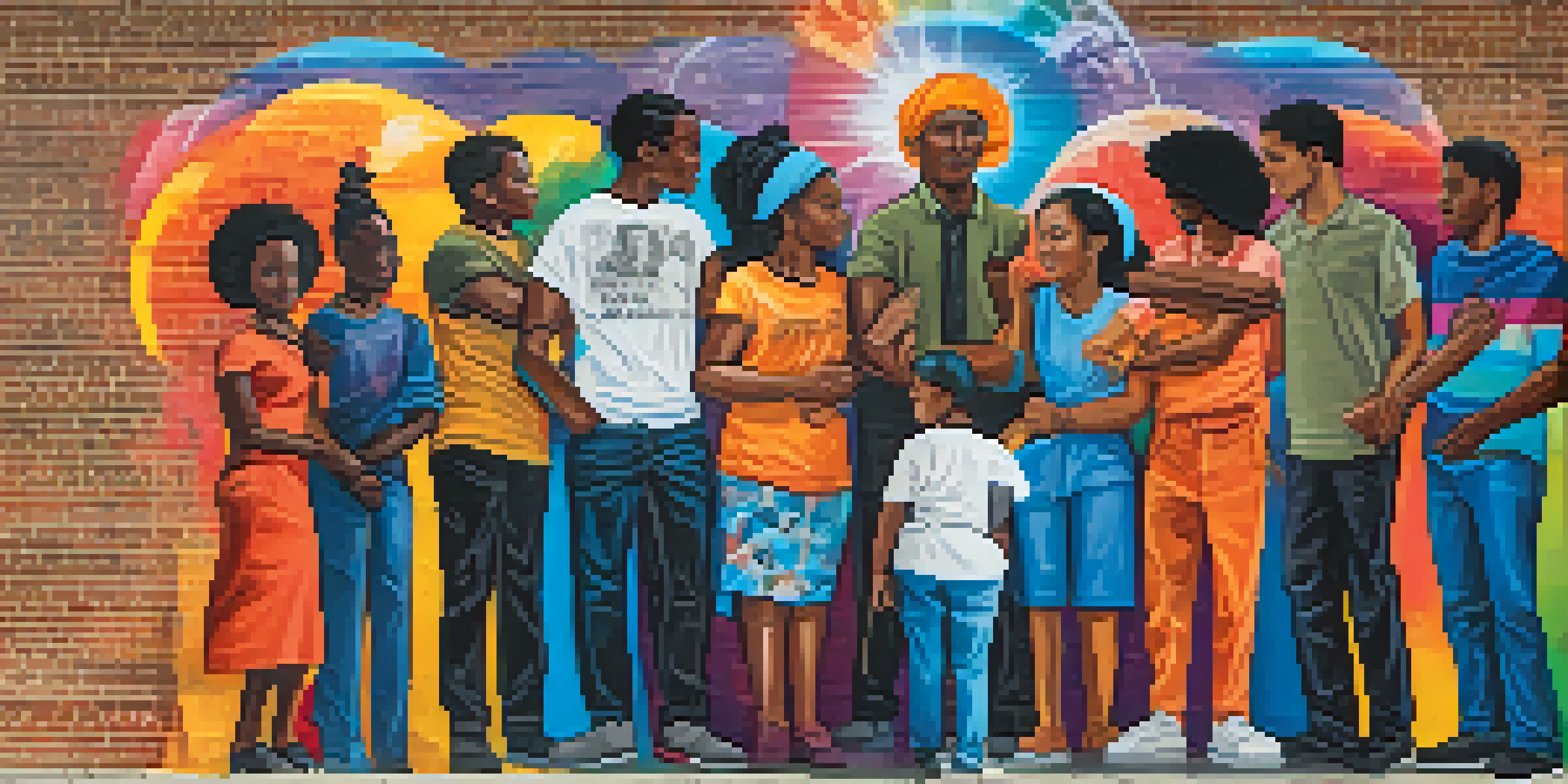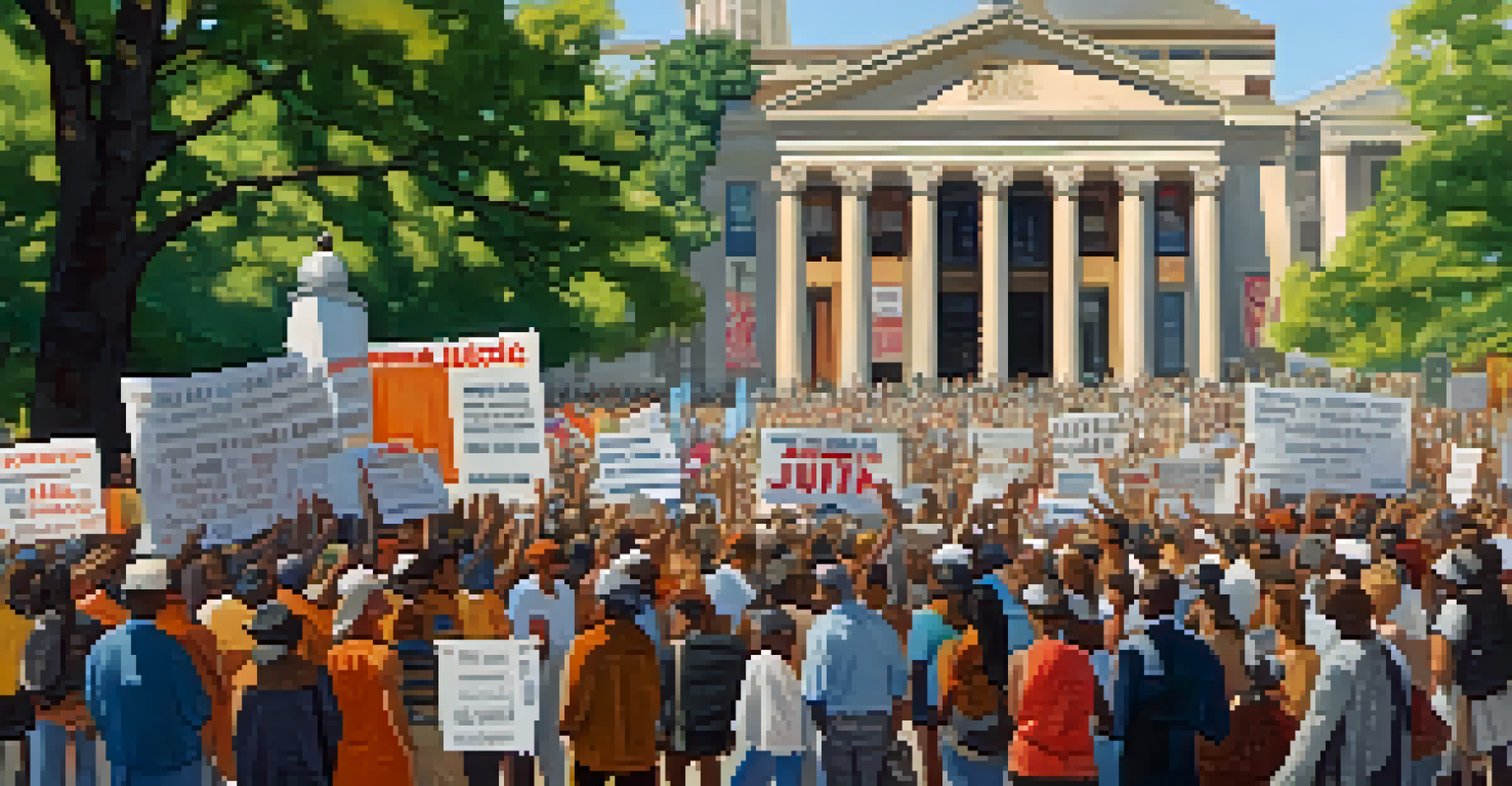The Influence of Social Media on Activist Art Movements

Understanding Activist Art in the Digital Age
Activist art serves as a powerful medium for social change, often challenging the status quo. In today's digital landscape, this form of expression has found a new ally in social media. Artists can now share their work globally, transcending geographic and cultural barriers, making their messages more impactful than ever.
Art is not a mirror to reflect the world, but a hammer with which to shape it.
The rise of platforms like Instagram and Twitter has democratized art, allowing voices that may have been marginalized to gain visibility. This accessibility encourages diverse perspectives, fostering a richer dialogue around social issues. By sharing their art online, activists can engage with broader audiences, sparking conversations that extend beyond traditional art spaces.
Additionally, the immediacy of social media allows artists to respond to events in real time. Whether it's a protest, a societal shift, or a moment of injustice, artists can create and share their work almost instantaneously, ensuring that their messages resonate with current events.
The Role of Hashtags in Activist Art Movements
Hashtags have become vital tools for organizing and amplifying activist art. By using specific hashtags, artists can connect their work to larger movements, such as #BlackLivesMatter or #MeToo, ensuring that their art reaches the right audience. This not only increases visibility but also fosters a sense of community among activists and artists alike.

For instance, when an artist creates a piece addressing police brutality and shares it with the hashtag #JusticeForAll, it can quickly spread across various platforms. This collective visibility helps unify voices around a common cause, creating a ripple effect that can lead to greater awareness and action.
Activist Art Thrives Online
Social media empowers activist artists to share their messages globally, fostering engagement and dialogue around social issues.
Moreover, hashtags can serve as a means of documentation, capturing the evolution of movements over time. By following specific tags, users can trace the progression of activist art and its impact, highlighting how creativity can drive societal change.
Visual Storytelling: Capturing Emotions Online
Visual storytelling has always been a powerful way to evoke emotions and convey messages. In the realm of activist art, social media allows artists to share their narrative in compelling and visually engaging ways. Through images, videos, and graphics, activists can tell stories that resonate deeply with viewers, fostering empathy and understanding.
The role of the artist is to make the revolution irresistible.
Consider the power of a striking image from a protest: it can capture the raw emotions of the moment, making it instantly relatable. When shared online, these visuals can evoke strong reactions, prompting viewers to engage, share, and participate in discussions about the issues at hand.
Additionally, visual storytelling can transcend language barriers, making art an accessible form of communication. This universal appeal allows activist art to reach a diverse audience, encouraging collective action and solidarity across different communities.
Social Media: A Double-Edged Sword for Artists
While social media offers incredible opportunities for activist artists, it also presents challenges. The pressure to constantly produce content can lead to burnout, as artists feel compelled to stay relevant in an ever-evolving digital landscape. This can detract from the quality and depth of their work, as they prioritize quantity over meaningful expression.
Furthermore, the potential for misinterpretation or appropriation of their art is a legitimate concern. When art is shared widely, it can be taken out of context, leading to unintended messages that may undermine the artist's original intent. This highlights the importance of context in activism, which can sometimes be lost in the fast-paced world of social media.
Hashtags Unite Activist Voices
By using targeted hashtags, artists can connect their work to larger movements, enhancing visibility and community among activists.
Finally, social media platforms themselves can perpetuate issues such as censorship. Artists may face restrictions on their work, especially if it challenges dominant narratives or power structures. Navigating these challenges is crucial for artists aiming to use their work effectively for social change.
Case Studies: Successful Activist Art Campaigns
Several activist art campaigns have successfully leveraged social media to amplify their messages. For example, the 'Fearless Girl' statue in New York City became a symbol of female empowerment and a viral sensation on platforms like Instagram. The statue's image sparked conversations about gender equality and women's rights, showcasing how art can initiate dialogue.
Another notable campaign is the 'Art Against War' movement, where artists from around the world created pieces in response to global conflicts. By sharing their works online, they united people in a shared vision of peace and solidarity, proving that art can be a powerful tool for activism.
These case studies illustrate the potential of social media to elevate activist art, allowing it to reach audiences far beyond traditional gallery spaces. By harnessing the power of digital platforms, artists can make a significant impact on social issues, inspiring others to take action.
Building Community Through Collaborative Art Projects
Social media has facilitated the rise of collaborative art projects that bring together diverse voices. Artists can connect with each other, share ideas, and create work that reflects a collective vision. This spirit of collaboration fosters a sense of community, making activism more inclusive and representative.
For instance, the 'PostSecret' project invites individuals to anonymously share their secrets through art and storytelling. This project, shared widely on social media, has created a safe space for vulnerability and connection, showcasing the power of collective expression.
Collaboration Enhances Impact
Collaborative art projects on social media create inclusive spaces for diverse voices, amplifying messages and driving collective action.
Collaborative projects also encourage cross-pollination of ideas, prompting artists to explore new perspectives and techniques. By working together, they can amplify their messages and create more meaningful art that resonates with wider audiences, further driving the activist agenda.
The Future of Activist Art in the Social Media Landscape
As technology and social media continue to evolve, the landscape of activist art will likely change as well. Emerging platforms and tools may offer new ways for artists to express their messages and engage with audiences. This constant evolution presents both challenges and opportunities for activists looking to make an impact.
One potential trend is the increasing use of augmented reality (AR) and virtual reality (VR) in activist art. These technologies can create immersive experiences, allowing viewers to engage with art in innovative ways that deepen their understanding of social issues. This could lead to more profound emotional connections and a greater call to action.

Ultimately, the future of activist art will depend on how artists navigate the complexities of social media, balancing the need for visibility with the importance of authenticity. As they adapt to the changing digital landscape, their ability to inspire change will remain a testament to the enduring power of creativity in social movements.